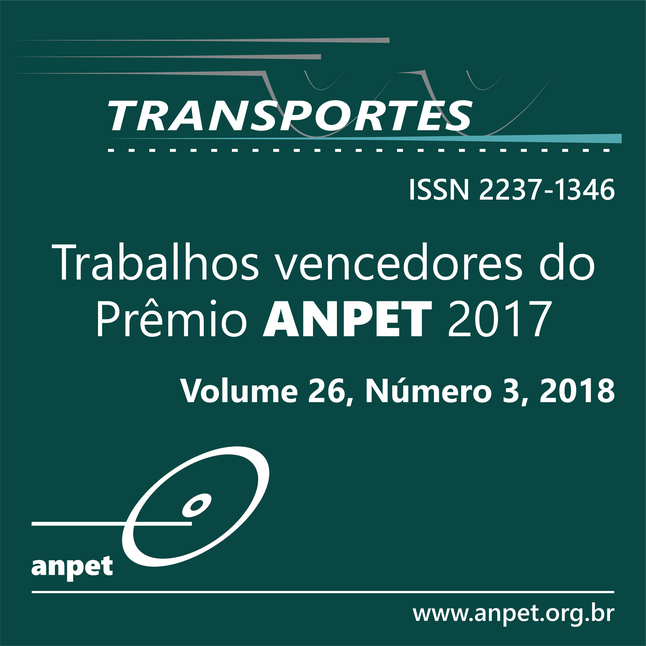Calibração do modelo de aceitação de brechas em interseções urbanas com o microssimulador de tráfego VISSIM
DOI:
https://doi.org/10.14295/transportes.v26i3.1603Keywords:
Two-way STOP-controlled intersections, Gap acceptance, Critical gap, Microscopic simulation, Calibration.Abstract
The main objective of this paper is to propose a method to model gap acceptance in urban two-way STOP-controlled intersections using VISSIM microscopic simulator. The proposed method is based on the time that the driver takes in the process of gap acceptance, that is, on the time that the vehicle stays in the first position of the queue. The c2 of the adherence between the waiting times’ distributions (simulated and observed) and the difference between the means were used for the critical gap estimation. The proposed method was applied to an intersection located in Fortaleza city. The results indicated slightly different critical gap values between turning movements. The second objective of this paper is to compare the proposed calibration procedure with the conventional one, in which the calibration target is a traffic measure of effectiveness, such as the average queue length. The proposed method yielded better results.Downloads
References
Brilon, W.; R. Koenig e R. J. Troutbeck (1999) Useful estimation procedures for critical gaps. Transportation Research Part A: Policy and Practice, v. 33, n. 3-4, p. 161-186. DOI:10.1016/S0965-8564(98)00048-2.
Depiante, V. S. e J. J. Galarraga (2012) Intervalos Criticos y Capacidad en Intersecciones no Semaforizadas de Tres Ramas. Congreso Panamericano de Ingeniería de Tránsito, Transporte y Logística, PANAM, Santiago, Chile.
Elefteriadou, L. (2014) An Introduction to Traffic Flow Theory. Ed. Springer, New York. DOI:10.1007/978-1-4614-8435-6.
Garber, N. J. e L. A. Hoel (2015) Traffic and Highway Engineering. 5. Ed. CL Engineering.
Jie, L.; H. V. Zuylen; Y. Chen; F. Viti e I. Wilmink (2013) Calibration of a Microscopic Simulation Model for Emission Calculation. Transportation Research Part C: Emerging Technologies, v. 31, n. 0, p. 172-184. DOI:10.1016/j.trc.2012.04.008.
Kyte, M.; M. Dixon e P. M. Basavaraju (2003) Why Field Measurements Differ from Model Estimates. Transportation Research Record: Journal of the Transportation Research Board, v. 1852, p. 32-39. DOI:10.3141/1852-05.
Lacerda, V. M. e M. M. Castro-Neto (2014) Considerações sobre a Calibração do Modelo de Car-following do VISSIM para Vias Arteriais Urbanas. Anais do XXVIII Congresso de Pesquisa e Ensino em Transportes, ANPET, Curitiba.
Lacerda, V. M. (2016) Estimação da Velocidade Média em Vias Urbanas com Uso do Microssimulador VISSIM. Dissertação (Mes-trado em Engenharia de Transportes). Programa de Pós-Graduação em Engenharia de Transportes, Universidade Fede-ral do Ceará, Fortaleza, CE.
Lidbe, A. D.; A. M. Hainen e S. L. Jones Jr. (2016) Comparative Study of Simulated Annealing and Genetic Algorithm for Cali-bration of Microsimulation Model. In: Transportation Research Board 95th Annual Meeting, Washington, USA.
Liu, P.; X. Q. H. Yu; W. Wang e B. Cao (2012) Development of a VISSIM Simulation Model for U-Turns at Unsignalized Intersec-tions. Journal of Transportation Engineering, v. 138, n.11, p. 1333-1339. DOI:10.1061/(ASCE)TE.1943-5436.0000438.
Martin-Gasulla, M.; A. García e C. Llorca (2017) Headway Acceptance Decisions on Single-Lane Roundabouts in Spain. Critical and Follow Headway. In: Transportation Research Board 96th Annual Meeting, Washington, USA.
Mohan, M. e S. Chandra (2016) Influence of Major Stream Composition on Critical Gap at Two-Way Stop-Controlled Intersec-tions. In: Transportation Research Board 95th Annual Meeting, Washington, USA.
PTV (2016) VISSIM 9.0. Manual do Usuário. Plannung Transport Verkehr AG, Karlsruhe, Germany.
Raff, M. S. (1950) A Volume Warrant for Urban Stop Signs. Eno Foundation for Highway Traffic Control, Saugatuck, Connecti-cut.
Tarko, A. e Z. Tian (2003) Example Analysis and Handling of Uncertainty in the Highway Capacity Manual with Consideration of Traffic Diversion. Transportation Research Record: Journal of the Transportation Research Board, v. 1852, p. 40-46. DOI:10.3141/1852-06.
TRB (2010) Highway Capacity Manual. Transportation Research Board, v. 3, Washington.
Viti, F.; B. Wolput; C. M. J. Tampère e P. Vandervelden (2013) Dynamic Modeling of VISSIM’s Critical Gap Parameter at Un-signalized Intersections. Transportation Research Record: Journal of the Transportation Research Board, v. 2395, p. 12-20. DOI:10.3141/2395-02.
Downloads
Published
How to Cite
Issue
Section
License
Authors who submit papers for publication by TRANSPORTES agree to the following terms:
- The authors retain the copyright and grant Transportes the right of first publication of the manuscript, without any financial charge, and waive any other remuneration for its publication by ANPET.
- Upon publication by Transportes, the manuscript is automatically licensed under the Creative Commons License CC BY 4.0 license. This license permits the work to be shared with proper attribution to the authors and its original publication in this journal.
- Authors are authorized to enter into additional separate contracts for the non-exclusive distribution of the version of the manuscript published in this journal (e.g., publishing in an institutional repository or as a book chapter), with recognition of the initial publication in this journal, provided that such a contract does not imply an endorsement of the content of the manuscript or the new medium by ANPET.
- Authors are permitted and encouraged to publish and distribute their work online (e.g., in institutional repositories or on their personal websites) after the editorial process is complete. As Transportes provides open access to all published issues, authors are encouraged to use links to the DOI of their article in these cases.
- Authors guarantee that they have obtained the necessary authorization from their employers for the transfer of rights under this agreement, if these employers hold any copyright over the manuscript. Additionally, authors assume all responsibility for any copyright infringements by these employers, releasing ANPET and Transportes from any responsibility in this regard.
- Authors assume full responsibility for the content of the manuscript, including the necessary and appropriate authorizations for the disclosure of collected data and obtained results, releasing ANPET and Transportes from any responsibility in this regard.











